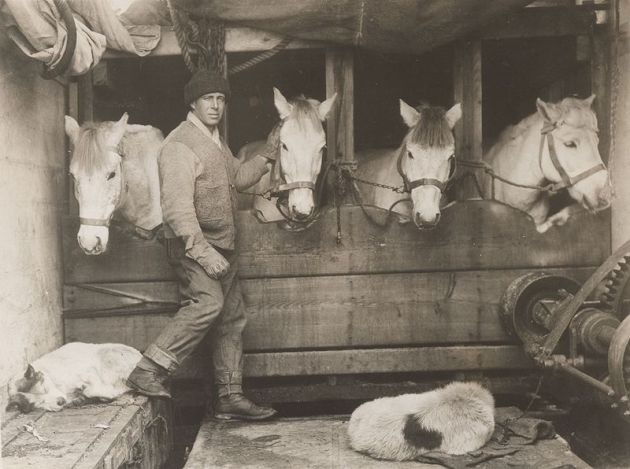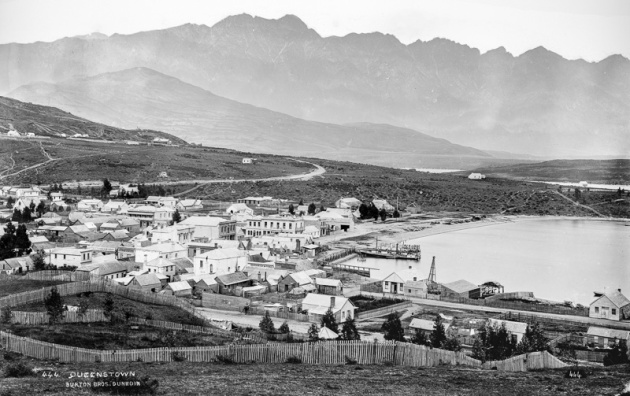Captain Scott had re-joined his ship at Cape Town for the voyage to Australia but, as the expedition was always short of money, public speaking and fund raising took priority. Second-in-Command, Lieutenant “Teddy” Evans continues….
Scott left us again at Melbourne and embarked on yet another begging campaign, whilst I took the ship on to Lyttelton, where the Terra Nova was dry-docked with a view to stopping the leak in her bows. The decks, which after her long voyage let water through sadly, were caulked, and barnacles six inches long were taken from her bottom and sides.

Lyttelton dry dock with the mail steamer Aorangi** taking up much more room than Terra Nova would have. Photo by Burton Brothers of Dunedin from the Te Papa collection.
Whilst in New Zealand all the stores were landed, sorted out and restowed. On a piece of waste ground close to the wharves at Lyttelton the huts were erected in skeleton in order to make certain that no hitch would occur when they were put up at our Antarctic base.

Instruments were adjusted, the ice-house re-insulated and prepared to receive the 150 frozen sheep and ten bullocks which were presented to us by New Zealand farmers. Stables were erected under the forecastle and on the upper deck of the Terra Nova, ready for the reception of our ponies, and a thousand and one alterations and improvements made.

Lawrence “Titus” Oates taking care of the expedition’s ponies in the forecastle. Neither Oates nor his ponies would return from “The Ice”.
We spent four weeks in Port Lyttelton, four weeks of hard work and perfect happiness. Our prospects looked very rosey in those days, and as each new member joined the Expedition here he was cordially welcomed into the Terra Nova family.
Mr. J. J. Kinsey acted as agent to the Expedition, as he had done for the National Antarctic Expedition of 1901-4, and, indeed, for every Polar enterprise that has used New Zealand for a base.
New Zealanders showed us unbounded hospitality; many of us had visited their shores before and stronger ties than those of friendship bound us to this beautiful country.
We sailed from Lyttelton on November 25 for Port Chalmers, had a tremendous send-off and a great deal of cheering as the ship moved slowly away from the piers. Bands played us out of the harbour and most of the ships flew farewell messages, which we did our best to answer.
Some members went down by train to Dunedin and joined us at Port Chalmers. We filled up here with what coal we could squeeze into our already overloaded ship and left finally for the Great Unknown on November 29, 1910.

Terra Nova about to leave Port Chalmers.

Capt. R.F. Scott. 1868-1912.
Lady Scott, Mrs. Wilson, and my own wife came out with us to the Heads and then went on board the Plucky tug after saying good-bye. We were given a rousing send-off by the small craft that accompanied us a few miles on our way, but they turned homeward at last and at 3.30 p.m. we were clear with all good-byes said – personally I had a heart like lead, but, with every one else on board, bent on doing my duty and following Captain Scott to the end.
There was work to be done, however, and the crew were glad of the orders that sent them from one rope to another and gave them the chance to hide their feelings, for there is an aweful feeling of loneliness at this point in the lives of those who sign on the ships of the “South Pole trade” – how glad we were to hide those feelings and make sail – there were some dreadfully flat jokes made with the best of intentions when we watched dear New Zealand fading away as the spring night gently obscured her from our view.
‘South With Scott’, Edward R. G. R. Evans, 1921. (Abridged)
** Just over two years later Scott’s wife, Kathleen, was a passenger on the Aorangi, (pictured at top in dry dock). She was on her way to New Zealand to be reunited with her husband. The ship was in mid-Pacific and out of radio range, so she hadn’t heard the news of his death.
From the New Zealand Times of 28th February 1913 – Lady Scott, widow of the late Captain Scott, arrived at Wellington from San Francisco by the Aorangi last evening. She was met by her brother, Lieutenant [Wilfred] Bruce, and came ashore in the Janie Seddon. The Aorangi left Papeete about 6 p.m. on February 18th, and at midnight a wireless message was received from the Talune, which was on her way from Auckland to the islands, and some 500 miles distant, that Captain Scott had perished in a blizzard after reaching the South Pole. Captain Stevens broke the news to Lady Scott next morning at breakfast time.
According to Lady Scott – ‘The poor old chap’s hands were trembling when he said, “I’ve got some news for you, but I don’t see how I can tell you.” I said; “The Expedition?” and he said, “Yes.” “Well,” I said, “let’s have it,” and he showed me the message.’
‘Scott of the Antarctic’, Reginald Pound, 1966.
There was a sad sequel to this episode two months later, with parallels to Kathleen Scott’s personal loss. On 30th April 1913, “poor old” Captain Stevens’ wife, Catherine, died aged 46, in Auckland – while he was on the Aorangi in San Francisco.
There were no headlines. We can only hope he met with a messenger as empathetic as he had been.

















 I shall never forget the day I first visited the Terra Nova in the West India Docks : she looked so small and out of place surrounded by great liners and cargo-carrying ships, but I loved her from the day I saw her, because she was my first command. Poor little ship, she looked so dirty and uncared for and yet her name will be remembered for ever in the story of the sea, which one can hardly say in the case of the stately liners which dwarfed her in the docks.
I shall never forget the day I first visited the Terra Nova in the West India Docks : she looked so small and out of place surrounded by great liners and cargo-carrying ships, but I loved her from the day I saw her, because she was my first command. Poor little ship, she looked so dirty and uncared for and yet her name will be remembered for ever in the story of the sea, which one can hardly say in the case of the stately liners which dwarfed her in the docks.


 She was laid up in London as a training ship for Sea Scouts by 1936. Taken over by the Admiralty in the ’50s, she became a familiar sight berthed in the Thames at Victoria Embankment (at left in 1970) but her condition declined over the next 20 years. The Maritime Trust saved her from the scrap yard, restored the old ship, and added her to their vintage collection at
She was laid up in London as a training ship for Sea Scouts by 1936. Taken over by the Admiralty in the ’50s, she became a familiar sight berthed in the Thames at Victoria Embankment (at left in 1970) but her condition declined over the next 20 years. The Maritime Trust saved her from the scrap yard, restored the old ship, and added her to their vintage collection at 
